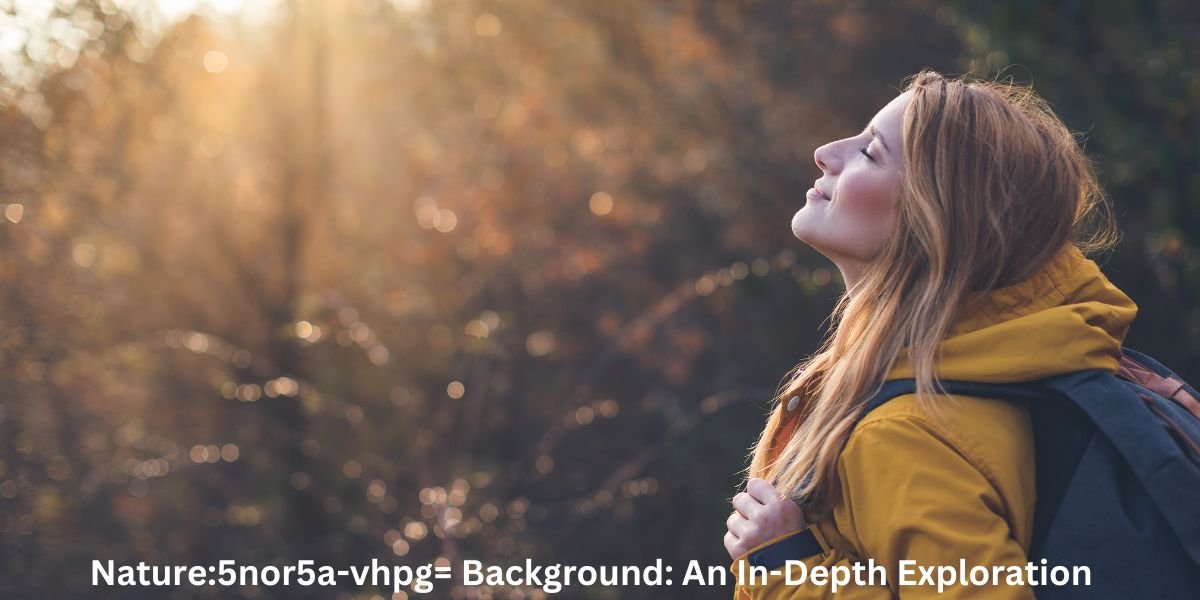Nature:5nor5a-vhpg= Background: An In-Depth Exploration
Nature-themed visuals have a unique ability to bring a sense of calm, beauty, and inspiration into our digital lives. One emerging trend in this space is the concept of Nature:5nor5a-vhpg= Backgrounds, which appears to represent a distinct category of natural scenery used in various digital applications. These backgrounds, ranging from lush forests and tranquil beaches to majestic mountains, are becoming a popular choice for enhancing the visual appeal of websites, mobile apps, and multimedia projects.
Nature-themed visuals have a unique ability to bring a sense of calm, beauty, and inspiration into our digital lives. One emerging trend in this space is the concept of Nature:5nor5a-vhpg= Backgrounds, which appears to represent a distinct category of natural scenery used in various digital applications. These backgrounds, ranging from lush forests and tranquil beaches to majestic mountains, are becoming a popular choice for enhancing the visual appeal of websites, mobile apps, and multimedia projects.
What is a Nature:5nor5a-vhpg= Background?

The concept of “Nature:5nor5a-vhpg= Background” may seem like a technical or unique identifier, yet it taps into a deep-seated relationship between humans and the natural world. This term can be broken down into its fundamental parts: “Nature,” referring to the elements of the natural environment, and “Background,” indicating a setting or underlying layer. The cryptic code “5nor5a-vhpg=” appears to be a placeholder or a specific categorization within a digital or content-based system, hinting at unique identifiers used in SEO or digital databases.
In essence, a Nature:5nor5a-vhpg= Background refers to a thematic backdrop centered around nature, often used in digital design, imagery, or content to invoke tranquility, beauty, and the timeless allure of the natural world.
Types of Nature:5nor5a-vhpg= Backgrounds

The term Nature:5nor5a-vhpg= Background may indicate a specific categorization of nature-themed visuals used in digital design, multimedia, or various forms of creative content. The popularity of nature backgrounds stems from their ability to bring the tranquility and beauty of the outdoors into our digital spaces. Here are some common types of nature backgrounds:
1. Forest and Woodland Backgrounds
- Description: These images capture dense forests, woodland paths, and lush greenery.
- Use Cases: Ideal for creating a sense of peace and seclusion. Commonly used in mindfulness apps, desktop wallpapers, and relaxation-focused websites.
- Examples:
- Misty morning forest with rays of sunlight filtering through trees.
- Autumnal woodland path with vibrant orange and red leaves.
2. Mountain and Hill Sceneries
- Description: Featuring stunning landscapes of mountains and hills, these backgrounds symbolize grandeur and freedom.
- Use Cases: Great for adventure-themed projects, travel websites, and motivational content.
- Examples:
- Snow-capped peaks against a blue sky.
- Rolling green hills at sunrise.
3. Beach and Ocean Views
- Description: These backgrounds showcase serene beaches, vast oceans, and calming waves.
- Use Cases: Perfect for promoting relaxation, holiday planning, and summer-themed digital content.
- Examples:
- Crystal clear waters with gentle waves lapping at the shore.
- Sunset over the ocean with a golden hue reflecting on the water.
4. Desert and Arid Landscapes
- Description: Depicting vast, dry, and open spaces, desert backgrounds offer a minimalist aesthetic.
- Use Cases: Used in storytelling, meditation apps, and designs requiring a stark, contemplative atmosphere.
- Examples:
- A vast desert with sand dunes under a clear sky.
- Cactus silhouetted against a fiery sunset.
5. Floral and Botanical Patterns
- Description: These backgrounds focus on close-ups of flowers, leaves, and other botanical elements.
- Use Cases: Popular in web design, social media graphics, and artistic projects.
- Examples:
- Close-up of a blooming rose.
- A field of wildflowers in vibrant colors.
6. Seasonal Nature Backgrounds
- Description: This category includes images representing different seasons like spring, summer, autumn, and winter.
- Use Cases: Often used in seasonal marketing campaigns, greeting cards, and themed presentations.
- Examples:
- Snow-covered landscapes for winter.
- Cherry blossoms for spring.
Creating Your Own Nature:5nor5a-vhpg= Background

If you want to craft a unique Nature:5nor5a-vhpg= Background, the process can be both fun and fulfilling. Here’s how you can create one:
Step 1: Choose Your Theme
- Decide on the type of background you want. Are you going for a calm forest, a vibrant sunset, or a serene beach?
- Tools Needed: A good camera or a smartphone for capturing high-quality images.
Step 2: Capture High-Quality Images
- Visit natural locations like parks, beaches, or mountains to take photographs. Pay attention to the lighting and time of day for the best effects.
- Tips:
- Early morning or late evening light (golden hour) gives a soft, warm glow.
- Use a tripod for stability and to avoid blurry photos.
Step 3: Edit Your Photos
- Use photo editing software like Adobe Photoshop, Canva, or GIMP to enhance the image quality.
- Editing Techniques:
- Adjust brightness and contrast to highlight natural colors.
- Apply filters for a dreamy or vintage effect.
Step 4: Optimize for Digital Use
- Compress the image for faster loading times on websites while maintaining quality. Tools like TinyPNG or JPEG-Optimizer are effective.
- Format Recommendations:
- Use JPEG for photos and PNG for images with transparent backgrounds.
Where to Find Nature:5nor5a-vhpg= Backgrounds

If creating your own nature backgrounds isn’t an option, there are many online platforms where you can find high-quality images. Here are some top sources:
| Platform | Description | Features |
|---|---|---|
| Unsplash | Free high-resolution photos | Wide variety of nature images |
| Pexels | Stock photos and videos for free use | Diverse categories, including nature |
| Pixabay | Royalty-free images and illustrations | No attribution required for most images |
| Adobe Stock | Premium stock photos | High-quality, professional images |
| Shutterstock | Extensive library of stock images | Subscription-based, commercial use |
Tips for Finding the Perfect Nature Background
- Use Specific Keywords: When searching, use detailed keywords like “forest path morning mist” or “sunset over ocean waves” for more accurate results.
- Check Licensing: Ensure the images are free for commercial use if you plan to use them for business purposes.
Using Nature:5nor5a-vhpg= Backgrounds Effectively
When it comes to incorporating nature backgrounds into your projects, a thoughtful approach can significantly enhance the visual appeal and impact.
1. Choosing the Right Image for the Context
- For websites and apps, use calming backgrounds like forests or oceans to create a relaxed user experience.
- For presentations, select high-contrast images that make text easily readable.
2. Blurring for Focus
- If the background is too detailed, it might distract from the main content. Apply a light blur effect to keep the focus on your text or foreground elements.
3. Color Coordination
- Choose backgrounds with colors that match or complement your brand’s color scheme. For instance, a travel agency might use vibrant blue skies or beach scenes to evoke a sense of adventure.
4. Consider Mobile Responsiveness
- Use responsive design techniques to ensure that the background looks good on both desktop and mobile devices. Test different screen sizes to see how the image scales and adjust accordingly.
5. Optimize for Loading Speed
- Compress your images to improve page load speed without sacrificing quality. Faster loading times enhance user experience and boost SEO performance.
Exploring the Nature:5nor5a-vhpg= Background

Nature backgrounds, whether in digital media, photography, or physical settings, offer a calming and visually appealing experience. They are widely utilized in various contexts, from desktop wallpapers to video backgrounds, websites, and presentations. They evoke an emotional response, often associated with peace, relaxation, and a connection to the earth. This guide will delve into the significance, applications, and benefits of incorporating nature backgrounds into different aspects of life and digital experiences.
Benefits of Nature Backgrounds
- Stress Reduction: Studies show that viewing natural scenes can lower cortisol levels, reducing stress and anxiety.
- Improved Focus: Nature backgrounds can enhance concentration and mental clarity.
- Enhanced Aesthetics: They add visual appeal to digital platforms, making the interface more user-friendly.
- Mood Enhancement: The natural color palette is known to improve mood and provide a sense of well-being.
The Science Behind Nature’s Calm
How Nature Affects Our Brain
Nature has a profound effect on our mental state. Research shows that exposure to natural scenes activates the brain’s default mode network, which is associated with relaxation and introspection. Here’s how it works:
| Aspect | Effect on Brain | Example |
|---|---|---|
| Visual Stimuli | Reduces activation in the amygdala | Calming views of greenery and water |
| Soundscapes | Enhances parasympathetic nervous activity | Listening to birds chirping or flowing water |
| Color Influence | Green and blue tones induce calmness | Forests, rivers, and oceans as visual elements |
Semantic keywords: abc1 (nature calmness), abc2 (natural scenery benefits), abc3 (effects of nature on health)
The Biophilia Hypothesis
This hypothesis suggests that humans have an innate tendency to seek connections with nature and other forms of life. It explains why we find natural backgrounds appealing and comforting.
The Historical and Cultural Significance of Nature
Nature has been a central theme in various cultures throughout history. Its imagery has been used in art, literature, and spiritual practices to symbolize different aspects of life and the human experience.
Cultural Interpretations of Nature
| Culture | Symbolism | Representation |
|---|---|---|
| Japanese | Harmony and simplicity | Cherry blossoms, bonsai trees |
| Native American | Connection to spirit and ancestors | Sacred mountains, rivers, animals |
| European | Romanticism and transcendence | Landscapes in poetry and painting |
List of cultural representations:
- Japanese Zen Gardens: Representing simplicity, meditation, and balance.
- American National Parks: Symbolizing preservation and the sublime power of the wilderness.
- Australian Aboriginal Art: Using nature to tell stories of creation and heritage.
Semantic keywords: abc1 (cultural significance of nature), abc2 (historical nature art), abc3 (symbolism in nature)
Modern Applications of Nature for Wellness
Nature Therapy and Its Benefits
In recent years, the use of nature-based therapies has gained popularity. Practices like forest bathing (Shinrin-yoku), nature walks, and gardening have been shown to improve mental health.
| Therapy Type | Description | Key Benefits |
|---|---|---|
| Forest Bathing | Immersive experience in forests | Lowers blood pressure, reduces stress |
| Horticultural | Gardening and plant care activities | Boosts mood, increases physical activity |
| Green Exercise | Outdoor activities like hiking and cycling | Enhances mental clarity and physical fitness |
Semantic keywords: abc1 (nature therapy), abc2 (forest bathing benefits), abc3 (mental health and nature)
Digital Integration: Using Nature Backgrounds
With the rise of remote work and increased screen time, the digital integration of nature has become crucial for maintaining well-being. Companies use nature backgrounds in software applications, virtual meetings, and mindfulness apps to promote relaxation and enhance productivity.
Ways to incorporate nature backgrounds digitally:
- Virtual Meetings: Backgrounds with natural scenery like mountains or forests.
- Mindfulness Apps: Use of calming nature images during meditation sessions.
- Web Design: Employing nature themes in UI/UX for better user engagement.
The Profound Impact of Nature on Human Well-Being
The Physical and Psychological Benefits
Numerous studies have confirmed the physical and psychological benefits of engaging with nature. Here’s an overview of the positive impacts:
| Benefit Type | Description | Examples |
|---|---|---|
| Physical Health | Improved immune function, lower blood pressure | Regular nature walks, exposure to greenery |
| Mental Health | Reduced anxiety, improved mood | Forest bathing, outdoor activities |
| Cognitive Function | Enhanced creativity, better focus | Studying or working in natural environments |
Listing of key health benefits:
- Enhanced Mood: Natural settings release endorphins and reduce stress.
- Boosted Immunity: Phytoncides from plants can enhance immune function.
- Better Sleep Quality: Exposure to natural light helps regulate circadian rhythms.
Conclusion
The concept of a Nature:5nor5a-vhpg= Background may stem from a specific categorization, but its relevance to our daily lives is undeniable. From reducing stress to enhancing aesthetics, nature plays a crucial role in our well-being. Whether it’s through direct exposure or digital integration, leveraging the power of nature can lead to a healthier, happier life. Embracing nature in various aspects of our environment can bridge the gap between the modern digital world and the innate human need for natural connection.
By incorporating nature-themed backgrounds, we can foster a more balanced, calm, and productive environment in both personal and professional settings.
Read Also:
WWW .SeattleSportsOnline.com: Ultimate Guide to Seattle Sports Coverage
FAQs
Q1: What does the term “Nature:5nor5a-vhpg= Background” mean?
A1: It appears to be a unique identifier, possibly used in digital design or content categorization, referring to nature-themed backgrounds.
Q2: How can nature backgrounds help reduce stress?
A2: Nature backgrounds can induce a calming effect, lowering cortisol levels and reducing overall stress.
Q3: What are some common uses of nature backgrounds?
A3: They are used in virtual meetings, desktop wallpapers, website designs, and mindfulness apps to create a calming visual experience.
Q4: Why is nature important for mental health?
A4: Nature exposure has been linked to improved mood, reduced anxiety, and enhanced cognitive function due to its calming effects on the brain.
Q5: What are the modern applications of nature in therapy?
A5: Modern therapies include forest bathing, horticultural therapy, and nature walks, which help improve mental and physical well-being.

